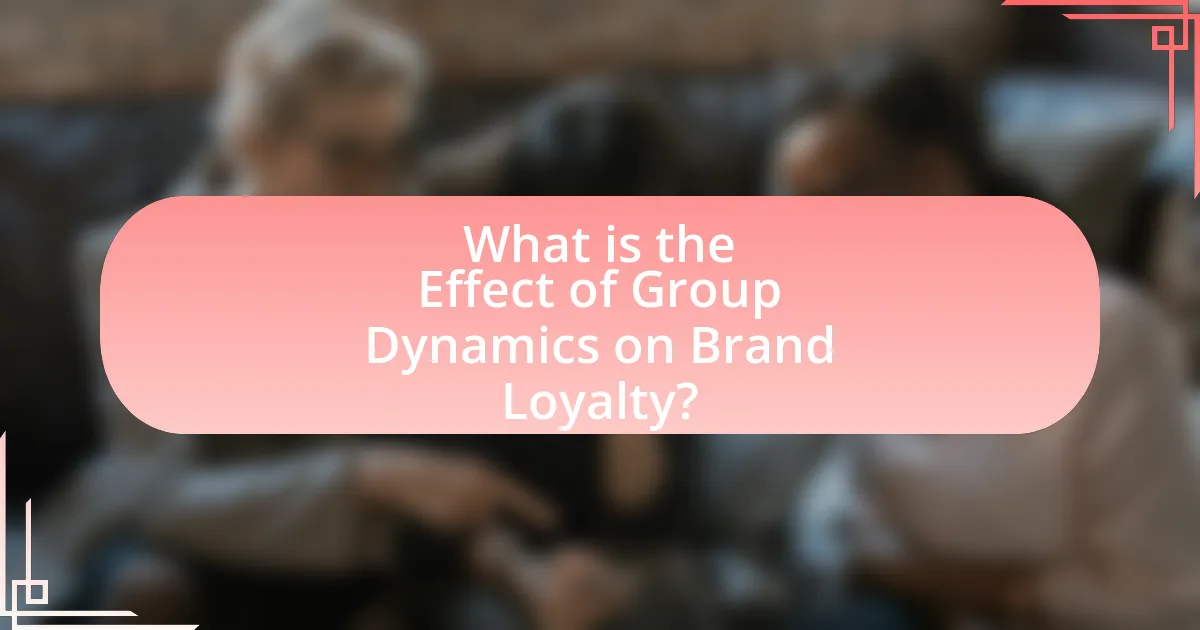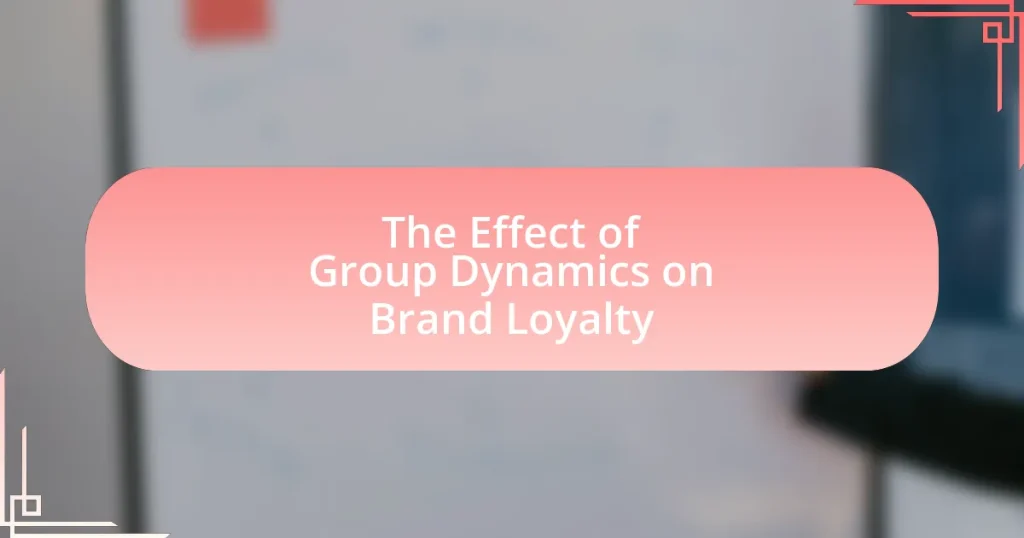The article examines the significant impact of group dynamics on brand loyalty, highlighting how social interactions and collective opinions shape consumer perceptions and behaviors. Key elements such as social influence, group cohesion, and shared identity are discussed, illustrating their roles in reinforcing brand commitment. The article also explores the differences between primary and secondary groups in influencing brand loyalty, the effects of groupthink, and strategies brands can implement to leverage group dynamics for enhanced consumer loyalty. Additionally, it emphasizes the importance of measuring group influence through various tools and metrics to better understand consumer sentiment and behavior.

What is the Effect of Group Dynamics on Brand Loyalty?
Group dynamics significantly influence brand loyalty by shaping consumer perceptions and behaviors within social contexts. When individuals engage in group settings, their attitudes towards a brand can be reinforced or altered based on collective opinions, social norms, and shared experiences. Research indicates that consumers are more likely to remain loyal to brands that are positively discussed within their social circles, as group consensus can enhance trust and perceived value. For instance, a study published in the Journal of Consumer Research found that group discussions can lead to increased brand commitment, particularly when individuals identify strongly with the group. This demonstrates that the social environment plays a crucial role in fostering brand loyalty through mechanisms such as social validation and emotional connection.
How do group dynamics influence consumer behavior towards brands?
Group dynamics significantly influence consumer behavior towards brands by shaping perceptions, preferences, and purchasing decisions through social interactions and group norms. When individuals are part of a group, they often look to others for cues on acceptable behavior, which can lead to conformity in brand choices. For instance, research indicates that consumers are more likely to choose brands that are popular within their social circles, as seen in a study by Cialdini et al. (2006), which highlights the impact of social proof on consumer decisions. Additionally, group discussions can enhance brand loyalty by reinforcing positive attitudes towards a brand, as individuals share experiences and recommendations, creating a collective endorsement that strengthens brand affinity.
What are the key elements of group dynamics that affect brand loyalty?
The key elements of group dynamics that affect brand loyalty include social influence, group cohesion, and shared identity. Social influence occurs when individuals in a group shape each other’s attitudes and behaviors towards a brand, often leading to increased loyalty due to peer pressure or recommendations. Group cohesion refers to the strength of relationships within the group, where a strong bond can enhance commitment to a brand that is favored by the group. Shared identity involves the alignment of personal values with the brand’s image, fostering a sense of belonging that reinforces loyalty. Research indicates that consumers are more likely to remain loyal to brands that resonate with their social groups, as demonstrated in studies showing that 70% of consumers are influenced by peer opinions when making purchasing decisions.
How do social interactions within groups shape brand perceptions?
Social interactions within groups significantly shape brand perceptions by influencing individual attitudes and behaviors towards brands. When individuals engage in discussions about brands within a group, they often share personal experiences and opinions, which can reinforce or alter their perceptions. For instance, a study published in the Journal of Consumer Research found that group discussions can lead to a phenomenon known as “social validation,” where individuals align their brand preferences with those of their peers, thereby enhancing brand loyalty. This alignment occurs because individuals seek acceptance and approval from their social circles, making them more likely to adopt the group’s collective view on a brand.
Why is understanding group dynamics important for brand loyalty?
Understanding group dynamics is crucial for brand loyalty because it influences consumer behavior and decision-making within social contexts. When individuals perceive a brand positively within their social groups, they are more likely to develop loyalty towards that brand. Research indicates that social identity theory suggests people derive part of their self-concept from their group memberships, which can enhance their attachment to brands that resonate with their group values. For instance, a study published in the Journal of Consumer Research found that consumers are more likely to remain loyal to brands that are endorsed by their peers or social groups, highlighting the impact of group dynamics on brand preference and loyalty.
What role does group identity play in brand loyalty?
Group identity significantly enhances brand loyalty by fostering a sense of belonging among consumers. When individuals identify with a group that shares similar values or interests, they are more likely to develop an emotional connection to brands that resonate with that identity. Research indicates that consumers often choose brands that reflect their group affiliations, as these brands serve as symbols of their identity. For instance, a study published in the Journal of Consumer Research found that individuals who identify strongly with a social group are more likely to exhibit loyalty to brands endorsed by that group, demonstrating that group identity can drive repeat purchases and brand advocacy.
How can brands leverage group dynamics to enhance loyalty?
Brands can leverage group dynamics to enhance loyalty by fostering community engagement and creating shared experiences among customers. By facilitating interactions through social media platforms, brands can encourage customers to share their experiences, thereby strengthening their emotional connection to the brand. Research indicates that consumers are more likely to remain loyal to brands that create a sense of belonging; for instance, a study published in the Journal of Consumer Research found that group identity significantly influences brand loyalty, as individuals often align their preferences with those of their social groups. Additionally, brands can implement loyalty programs that reward group participation, further incentivizing collective engagement and reinforcing loyalty through shared rewards.

What are the different types of group dynamics that impact brand loyalty?
Different types of group dynamics that impact brand loyalty include social influence, group cohesion, and conformity. Social influence occurs when individuals are affected by the opinions and behaviors of others, leading to increased brand loyalty through peer recommendations. Group cohesion refers to the strength of relationships within a group, which can enhance loyalty as members feel a sense of belonging and shared identity with a brand. Conformity involves individuals aligning their attitudes and behaviors with group norms, often resulting in heightened brand loyalty as consumers seek acceptance within their social circles. Research indicates that these dynamics significantly shape consumer behavior, with studies showing that 70% of consumers are influenced by peer recommendations when making purchasing decisions.
How do primary and secondary groups affect brand loyalty differently?
Primary groups, such as family and close friends, significantly influence brand loyalty through emotional connections and trust, while secondary groups, like acquaintances and professional networks, affect brand loyalty more through social status and information sharing. Emotional ties in primary groups lead to stronger brand attachment, as individuals often align their preferences with those of their close relationships. In contrast, secondary groups may shape brand perceptions based on trends or peer influence, resulting in a more superficial loyalty that can shift with changing social dynamics. Research indicates that consumers are more likely to remain loyal to brands endorsed by primary group members, as these endorsements carry more weight due to established trust and familiarity.
What characteristics define primary groups in relation to brand loyalty?
Primary groups are characterized by close, personal relationships that significantly influence brand loyalty. These groups, such as family and close friends, foster emotional connections and shared experiences, which enhance consumer trust and commitment to specific brands. Research indicates that individuals are more likely to remain loyal to brands endorsed by their primary groups, as these relationships create a sense of belonging and validation. For instance, a study published in the Journal of Consumer Research found that social ties within primary groups can lead to increased brand loyalty due to the perceived social approval associated with group preferences.
How do secondary groups influence consumer choices and brand attachment?
Secondary groups significantly influence consumer choices and brand attachment by shaping perceptions, preferences, and behaviors through social interactions and shared values. These groups, which include friends, colleagues, and social networks, create a context in which individuals seek validation and acceptance, often leading them to align their purchasing decisions with the preferences of the group. Research indicates that consumers are more likely to choose brands that are favored by their secondary groups, as this alignment enhances their social identity and belongingness. For instance, a study published in the Journal of Consumer Research found that individuals are influenced by the opinions of their peers, with 78% of participants reporting that they trust recommendations from friends over traditional advertising. This demonstrates that secondary groups play a crucial role in establishing brand loyalty by reinforcing positive associations with specific brands through social proof and collective endorsement.
What is the impact of groupthink on brand loyalty?
Groupthink negatively impacts brand loyalty by fostering conformity and suppressing individual opinions within consumer groups. This phenomenon can lead to a lack of critical evaluation of a brand’s offerings, resulting in consumers making decisions based on group consensus rather than personal preferences. For instance, when a group collectively endorses a brand without considering alternatives, it may create a false sense of security about the brand’s quality, which can diminish the likelihood of exploring other options. Research indicates that groupthink can lead to a decrease in brand loyalty over time, as consumers may feel less personally connected to a brand when their choices are heavily influenced by group dynamics rather than individual assessment.
How does groupthink lead to conformity in brand preferences?
Groupthink leads to conformity in brand preferences by creating an environment where individuals prioritize consensus over critical evaluation. In groupthink scenarios, members often suppress dissenting opinions to maintain harmony, which results in a collective agreement on brand choices without thorough analysis. Research by Janis (1972) highlights that this phenomenon can lead to poor decision-making, as individuals may adopt the prevailing brand preference of the group, even if it contradicts their personal beliefs or experiences. Consequently, the pressure to conform can significantly influence consumer behavior, reinforcing brand loyalty based on group consensus rather than individual assessment.
What are the potential downsides of groupthink for brand loyalty?
Groupthink can negatively impact brand loyalty by stifling individual opinions and promoting conformity, which may lead to a lack of innovation and responsiveness to consumer needs. When consumers feel pressured to align with group opinions, they may overlook personal preferences, resulting in a superficial attachment to a brand rather than a genuine loyalty. This phenomenon can be evidenced by studies showing that brands relying heavily on social validation may fail to adapt to changing market demands, ultimately losing loyal customers who seek authenticity and differentiation.

How can brands effectively utilize group dynamics to foster loyalty?
Brands can effectively utilize group dynamics to foster loyalty by creating community-driven experiences that encourage interaction among customers. By facilitating group engagement through social media platforms, loyalty programs, and events, brands can enhance the sense of belonging among consumers. Research indicates that individuals are more likely to remain loyal to brands that foster community, as evidenced by a study published in the Journal of Consumer Research, which found that social connections significantly influence brand loyalty. Additionally, brands can leverage user-generated content and testimonials to strengthen group identity, further solidifying customer commitment.
What strategies can brands implement to engage groups effectively?
Brands can implement strategies such as creating community-driven campaigns, leveraging social media for group interactions, and offering personalized experiences to engage groups effectively. Community-driven campaigns foster a sense of belonging and encourage group participation, which can enhance brand loyalty. For instance, brands like Nike have successfully utilized community events and challenges to engage groups, resulting in increased customer loyalty and brand advocacy. Leveraging social media platforms allows brands to facilitate discussions and interactions among group members, creating a dynamic environment that encourages sharing and collaboration. Additionally, offering personalized experiences tailored to group preferences can strengthen emotional connections, as evidenced by research indicating that personalized marketing increases customer engagement by up to 20%. These strategies collectively enhance group dynamics, leading to improved brand loyalty.
How can brands create community-driven marketing initiatives?
Brands can create community-driven marketing initiatives by fostering engagement through interactive platforms and user-generated content. By utilizing social media channels, brands can encourage customers to share their experiences and stories, which builds a sense of belonging and loyalty within the community. Research indicates that 79% of consumers are more likely to engage with brands that actively involve them in the marketing process, demonstrating the effectiveness of community-driven strategies. Additionally, hosting events or creating online forums where customers can connect with each other and the brand enhances the community aspect, further solidifying brand loyalty.
What role do influencers play in shaping group dynamics for brand loyalty?
Influencers play a crucial role in shaping group dynamics for brand loyalty by leveraging their social capital to create a sense of community and trust among followers. Their ability to engage audiences through relatable content fosters emotional connections, which are essential for building brand loyalty. Research indicates that 49% of consumers depend on influencer recommendations when making purchasing decisions, highlighting the significant impact influencers have on group perceptions and behaviors towards brands. By aligning their personal brand with specific products, influencers can effectively sway group opinions, leading to increased brand loyalty within their follower communities.
What are the best practices for measuring the impact of group dynamics on brand loyalty?
The best practices for measuring the impact of group dynamics on brand loyalty include utilizing surveys to assess consumer perceptions, conducting focus groups to gather qualitative insights, and analyzing social media interactions to gauge community engagement. Surveys can quantify how group affiliations influence brand preferences, while focus groups provide deeper understanding of emotional connections within groups. Additionally, social media analysis reveals how group dynamics shape brand discussions and loyalty behaviors, supported by studies showing that consumers often rely on peer opinions in their purchasing decisions. For instance, research by Cialdini et al. (2006) highlights the significant role of social influence in consumer behavior, reinforcing the importance of these measurement practices.
How can brands assess consumer sentiment within groups?
Brands can assess consumer sentiment within groups by utilizing social listening tools and sentiment analysis algorithms. These technologies analyze online conversations, reviews, and social media interactions to gauge the emotional tone and opinions expressed by consumers. For instance, a study by Nielsen found that 92% of consumers trust recommendations from friends and family over any other form of advertising, highlighting the importance of group dynamics in shaping brand perceptions. By monitoring discussions in relevant online communities, brands can identify trends, sentiments, and potential areas for improvement, allowing them to tailor their marketing strategies effectively.
What tools and metrics are effective for evaluating group influence on brand loyalty?
Effective tools and metrics for evaluating group influence on brand loyalty include social network analysis, sentiment analysis, and customer loyalty surveys. Social network analysis helps identify key influencers within a group and their impact on brand perception, while sentiment analysis measures the emotional tone of discussions surrounding a brand, providing insights into group attitudes. Customer loyalty surveys quantitatively assess brand loyalty levels and can segment responses by group demographics, revealing how group dynamics affect loyalty. Research indicates that brands leveraging these tools can enhance their understanding of consumer behavior, leading to improved marketing strategies and increased brand loyalty.
What practical tips can brands follow to enhance loyalty through group dynamics?
Brands can enhance loyalty through group dynamics by fostering community engagement and creating shared experiences among customers. By establishing platforms for customers to interact, such as social media groups or brand-sponsored events, brands can cultivate a sense of belonging. Research indicates that consumers are more likely to remain loyal to brands that facilitate social connections; for instance, a study by McKinsey found that 70% of consumers who engage with a brand on social media feel more connected to it. Additionally, implementing loyalty programs that reward group participation, such as team challenges or group discounts, can further strengthen these bonds. This approach not only encourages repeat purchases but also amplifies word-of-mouth marketing, as satisfied customers share their positive experiences within their social circles.


